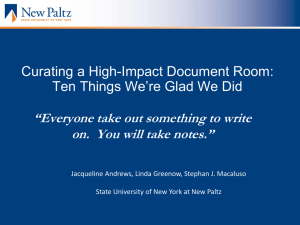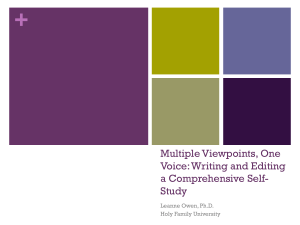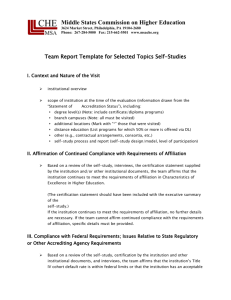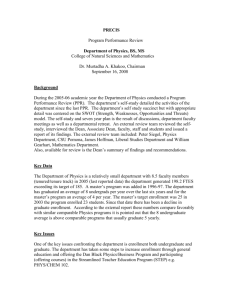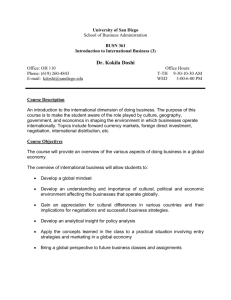Robert Morris College - Robert Morris University
advertisement
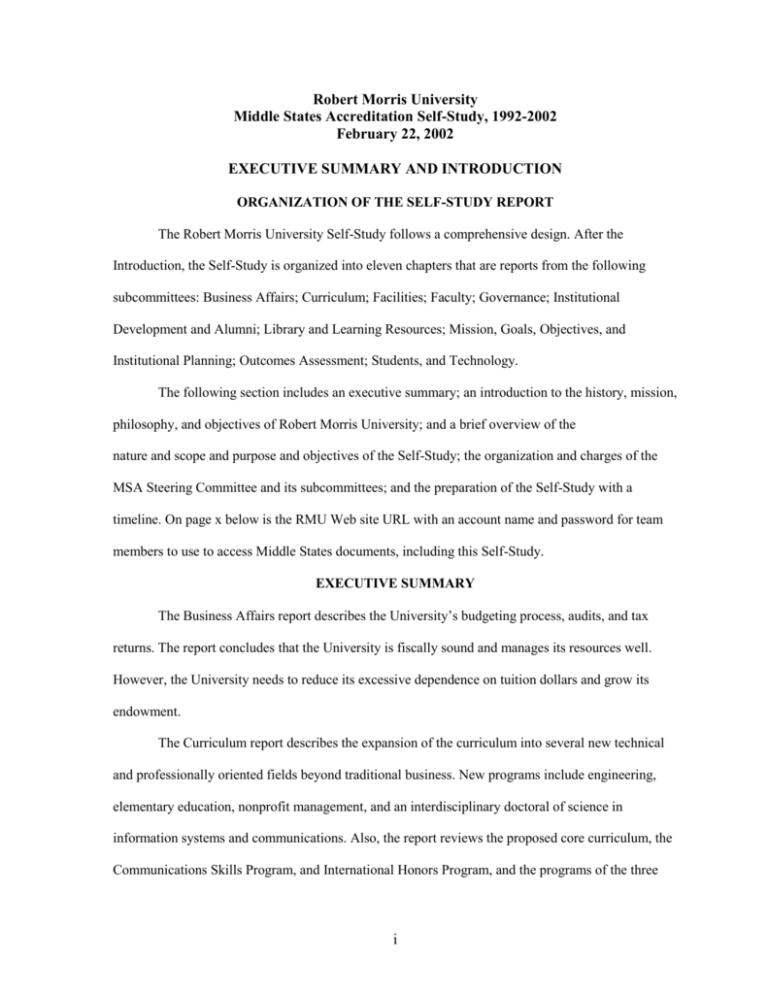
Robert Morris University Middle States Accreditation Self-Study, 1992-2002 February 22, 2002 EXECUTIVE SUMMARY AND INTRODUCTION ORGANIZATION OF THE SELF-STUDY REPORT The Robert Morris University Self-Study follows a comprehensive design. After the Introduction, the Self-Study is organized into eleven chapters that are reports from the following subcommittees: Business Affairs; Curriculum; Facilities; Faculty; Governance; Institutional Development and Alumni; Library and Learning Resources; Mission, Goals, Objectives, and Institutional Planning; Outcomes Assessment; Students, and Technology. The following section includes an executive summary; an introduction to the history, mission, philosophy, and objectives of Robert Morris University; and a brief overview of the nature and scope and purpose and objectives of the Self-Study; the organization and charges of the MSA Steering Committee and its subcommittees; and the preparation of the Self-Study with a timeline. On page x below is the RMU Web site URL with an account name and password for team members to use to access Middle States documents, including this Self-Study. EXECUTIVE SUMMARY The Business Affairs report describes the University’s budgeting process, audits, and tax returns. The report concludes that the University is fiscally sound and manages its resources well. However, the University needs to reduce its excessive dependence on tuition dollars and grow its endowment. The Curriculum report describes the expansion of the curriculum into several new technical and professionally oriented fields beyond traditional business. New programs include engineering, elementary education, nonprofit management, and an interdisciplinary doctoral of science in information systems and communications. Also, the report reviews the proposed core curriculum, the Communications Skills Program, and International Honors Program, and the programs of the three i Schools. Finally, the report describes the Bayer Center for Nonprofit Management and the Division of Adult and Continuing Education. The report notes that the Schools are seeking specialized accreditations (ABET, ABET-CAC, and AACSB) and working to integrate the disciplines more thoroughly into their programs and incorporating technology into their courses. As programs expand, the Schools seek the faculty and resources to support them. The Facilities report describes the development and implementation of the Master Plan. It also surveys the state of RMU facilities and concludes that it is good. The campus is a safe, secure environment with many new improvements in housing, faculty offices, other student facilities, and grounds. The Faculty report notes that RMU faculty are generally well prepared to support the programs the university offers. RMU encourages faculty development through good training programs, especially in technology, and support for research through travel funds and release time. RMU also encourages innovative pedagogy and curriculum. The faculty is represented by the RMU Federation of Teachers (AFT), which monitors program changes and conditions of employment. The report also reviews the hiring and support of part-time faculty. The report recommends hiring more full-time faculty, improving monetary incentives for meritorious achievement, and continued faculty development programs. The Governance report reviews the administrative structure of the Board of Trustees and the University and discusses the results of its survey of the University community. The survey shows that most are very satisfied with institution’s leadership and that there are multiple channels of communication used to discuss University actions. However, about half of the faculty would like more timely notice about important decisions that affect them. The report recommends that the Board diversify and add educators to its membership, the University continue to use technology to improve communications, and the administration promote more participatory deliberative efforts. The Institutional Development and Alumni report notes that the institutional advancement office has raised significant funds in the past decade through fundraising efforts that support clearly ii defined campaign goals. The report further notes that the office of institutional advancement is in transition with a new vice president for institutional advancement (hired July 2001). He has developed a new departmental plan, which the report describes, to increase substantially the weak financial support the University receives from its alumni. The Library and Learning Resources report concludes that the library and learning resources, including staff and budgets, of Robert Morris University are appropriate and adequate to support its academic programs. Although new initiatives are the primary driver for purchasing electronic resources for the RMU Library, librarians meet regularly to modify to the collection's print/digital balance and to plan a significant weeding of the collection to meet curricular and faculty research needs. The subcommittee recommends that the library keep abreast of the changing technological developments and that academic program leaders continue regular discussions about their needs with the librarians. The Mission, Goals, Objectives, and Institutional Planning report describes how the mission, goals, and objectives relate to strategic planning in decision making at RMU. The subcommittee recommends that the administration improve communicating the strategic plan to the RMU community, including annual progress towards goals, and create planning unit of school deans and faculty to set University-wide priorities. The Outcomes Assessment report describes the outcomes assessment process at RMU as a whole and examines University-wide assessment efforts. The subcommittee recommends that the University institutionalize a commitment to outcomes assessment, implement the 2001 revisions to the Outcomes Assessment Plan, make integrity a fundamental concept of assessment, establish a proper procedure for coordinating and recording assessment information, pay more and better attention to external constituencies, build effective assessment requirements into all new programs from the beginning, and make assessment an opportunity. How the University can implement these recommendations is discussed in the Outcomes Assessment Plan in the Appendix of the Self-Study. The Students report describes student services and programs and examines the extent to iii which these services meet the needs of a diverse student population and the degree to which they are effective in meeting the University’s mission, goals, and objectives. The subcommittee concludes that the evaluation of the programs and services in student affairs has improved markedly in recent years and it should continue and encompass each of the student programs and services. It also recommends that faculty members need additional training to perform student advising effectively. And the University should continue periodic review of policies to maintain congruence between institutional policy and practice. The Technology report describes the University’s $7 million Five-Year Technology Plan, its origin in multiple needs assessments, and its implementation. The report concludes that the Plan is meeting well the University’s needs for technology. The report’s recommendations include continuing using assessment results for planning and monitoring the implementation of the Technology Plan. INTRODUCTION Robert Morris University: History, Mission, Philosophy, And Objectives History Robert Morris University was founded in 1921 as the Pittsburgh School of Accountancy. In 1935, the school was named The Robert Morris School in honor of the famous Pennsylvanian who was the financier of the American Revolution. The facilities and operations of the Robert Morris School were purchased by a nonprofit corporation in 1962. With the approval of the Pennsylvania Department of Education, the school then became Robert Morris Junior College. The Commission on Institutions of Higher Education of the Middle States Association of Colleges and Secondary Schools granted accreditation initially in 1968. In 1969, when the Pennsylvania Department of Education granted the University the right to award the bachelor of science in business administration degree, the name was changed to Robert Morris College. The University received program approval from the Pennsylvania Department of Education in 1975 to prepare secondary teachers of business education. iv In 1977 the Pennsylvania Department of Education granted the University the right to award the master of science degree and in 1988 the right to award the master of business administration degree and the bachelor of arts degree with programs in English and communication. Also, in 1988 the Pennsylvania Department of Education granted approval for the University to certify teachers of English and communication. Since 1990 the University has continued to diversify its curriculum to enhance its business degrees, and build programs in other areas, including new bachelor of science and bachelor of arts degrees, master’s degrees, and a doctorate in technical and professionally oriented fields. During that decade, thirteen bachelor of science and bachelor of arts degrees were approved in the following fields: Economics, Elementary Education, Engineering, Hospitality and Tourism, Information Sciences, Mathematics, and Social Sciences. A doctorate and four new master’s degrees were also added in the fields of Business, Communication, Education, and Information Sciences. In addition, the University was authorized to certify teachers in the fields of Mathematics, Social Science, Elementary Education, and Instructional Technology Specialist. In recognition of these changes, the Carnegie Foundation for the Advancement of Teaching reclassified the University in the 2000 edition of the Carnegie Classification into the Master’s (Comprehensive) Colleges and Universities I category. In May 2001 the Pennsylvania Department of Education granted the institution university status. The formal change to Robert Morris University was effective January 14, 2002. It is the policy of Robert Morris University to provide equal opportunity in all educational programs and activities, admission of students and conditions of employment for all qualified individuals regardless of race, color, sex, religion, age, disability, sexual orientation or national origin. v Mission and Vision Robert Morris University is an independent, co-educational institution offering high-quality undergraduate and graduate degree programs that integrate the liberal arts with technical and professional programs (Mission Statement). The University seeks to be a leader in providing high-quality technical and professional education at moderate cost to qualified students seeking preparation for careers in business, communications, government, education, information sciences, applied science, engineering, and health-related fields. The University shall be known for its innovative curricula, integrating communications and information sciences in all disciplines and providing superior services to students and employers seeking graduates with technical and professionally oriented degrees emphasizing applied knowledge (Vision Statement). The mission of Robert Morris University focuses on one of the primary reasons students seek both undergraduate and graduate degrees in a modern, technological society, i.e., employment in career fields that enable them to prosper and contribute economically and personally as citizens in an increasingly competitive and changing world. Students have always chosen Robert Morris University because of its strong reputation and affordable cost, a reputation gained over the last seventy-five years by providing curricula that are responsive to the needs of business and industry and to students in the Pittsburgh region and beyond. In recognition of this historical role, in 1998 the Board of Trustees requested a review of the mission and a re-affirmation of the role that has been evolving since the University was founded as the Pittsburgh School of Accountancy in 1921. Since the founding, when only a certificate in accounting was awarded, RMU has evolved into a complex institution that has changed and broadened its curricular offerings and degrees as the needs of employers have changed and the desires of students have focused increasingly on preparation for careers. Today, RMU offers certificates and degrees through the doctorate in thirty-two undergraduate fields of study and twelve graduate fields. vi But, in a real sense the core of the mission has changed little over most of these years and can be succinctly summarized: Philosophy and Objectives To carry out its mission at the undergraduate level, the University shall: provide an academic environment that integrates liberal and professional learning; promote the acquisition of both general and specialized knowledge; develop abilities and skills in communication, problem-solving, and using technology to analyze, synthesize, and disseminate knowledge; incorporate practical experiences in curricula that enhance learning; offer small classes that encourage interaction with qualified faculty members who have professional experience and excellent academic credentials; and prepare students to successfully launch careers upon graduation or go on to graduate or professional schools. At the graduate level, the University shall: meet the needs of adults for professional degrees that improve their career opportunities and meet the needs of employers for advanced knowledge; provide professional and advanced degrees that build upon the strength of our undergraduate programs; develop inquiry skills that enable students to conduct advanced research in professional fields of study; create opportunities for working adults to engage in life-long education; and enhance the region’s base of “knowledge workers” that is vital to a strong economy. NATURE AND SCOPE OF SELF-STUDY During the past ten years, increased competition including the state of Pennsylvania permitting proprietary schools such as the University of Phoenix to offer bachelor's degrees, the drop vii in college freshmen seeking traditional business degrees, and the development of distance learning have caused Robert Morris University to value strategic planning to focus the institution's resources in delivering the most effective teaching and curriculum to the students of western Pennsylvania and beyond. RMU has engaged in University-wide planning process since 1992. These strategic planning initiatives have resulted in significantly focused goals that have been completed or are in the process of being completed. The planning efforts have involved faculty and administrators as well as the board of trustees, and in 1997 resulted in the development of a Five-Year Strategic Plan for the institution. The plan has been updated annually, and RMU is has recently finished its second complete version of the Five-Year Strategic Plan for 2002-2007. These planning programs are necessary to create broad and significant perspectives that alter the existing operations of the University for the better and promote change for the future. One of the goals of the Self-Study is to measure how well RMU has done this. In the past ten years the RMU has expanded its programs and curricula to achieve its mission and vision. Because of significant institutional evolution and change, the Middle States Accreditation Steering Committee has chosen a comprehensive Self-Study to help the institution assess its strengths and weaknesses and develop strategic plans based on the results. This design will ensure that all areas of the University benefit from examination and evaluative recommendations. Equally important, a comprehensive self-study ensures that the process includes as many members of the University community as possible. The Steering Committee seeks to examine every aspect of the University, including the University's mission as it relates to its stakeholders--its students, faculty and staff, business and the professions, and the community in western Pennsylvania. PURPOSE AND OBJECTIVES OF THE SELF-STUDY The purpose of the Middle States Self-Study process is to engage the RMU community in self-examination of its mission, goals, academic programs, policies, procedures, student services, resources and strategic planning in order to ensure continued quality, accountability and direction. viii The Self-Study objectives are To bring together groups with a wide representation to discuss the strengths and weaknesses of the University. To review the planning process and resource allocation in relation to the changing needs of the University. To assess the effectiveness of curricula, programs, and services and to make recommendations to improve the effectiveness of the University based on the outcomes. To present the University with recommendations for solving problems. To develop a faculty and staff who become better informed by gaining knowledge beyond their own areas of responsibility. To develop an institution-wide consensus about the future direction of the University. MSA STEERING COMMITTEE: ORGANIZATION AND CHARGE The Middle States Steering Committee and its Chair were selected by the President and Senior Vice President for Academic Affairs and Student Services. The Steering Committee comprises representatives from administration, faculty from each of the three schools, staff, and students. The Steering Committee chose the design for the Self-Study as well as the Self-Study subcommittees. Letters of invitation to solicit volunteers to join the Self-Study teams as well as to volunteer to be chair of a team were sent to faculty, professional staff, administrators and students. The Steering Committee sought broad representation from the University community to form the subcommittees. Next, the Steering Committee created job descriptions for subcommittee chairs after which each subcommittee met in an orientation session to select its own chairperson. (See Self-Study Design for details.) ix Factors taken into consideration when filling teams included academic discipline, university position, and diversity. This procedure was designed to enrich the Self-Study process by permitting the development of ideas and perspectives from a heterogeneous team. Membership of each study team included teaching and non-teaching instructional staff, administration and students. Self-Study teams also included consultants from the areas being studied to provide their specialized insight. However, to foster objectivity and new ideas, these consultants did not serve as subcommittee chairs. MSA SELF-STUDY SUBCOMMITTEES: ORGANIZATION AND CHARGES Robert Morris University conducted the Middle States Self-Study by using a comprehensive approach. To study the broad aspects of the University, the Steering Committee developed twelve Self-Study subcommittees. The Self-Study subcommittee charges are detailed in the Self-Study Design. PREPARATION OF THE SELF-STUDY REPORT The TIMELINE on the following pages reflects the process RMU followed in the preparation of the Self-Study Report. After the Steering Committee was organized, it formed subcommittees and gave them their charges. The Head of Institutional Research gathered all outcomes assessment materials, inventoried them on an Excel spreadsheet posted on the RMU Middle States Web site, and prepared notebooks with relevant outcomes assessment materials for each subcommittee. He also arranged for MSA materials to be located in the Library archives room for subcommittee use. The Chair of the Steering Committee posted all materials that were in electronic form on the Web in Sentry Secured Services for access to the subcommittees and any interested faculty or staff. Dr. Erickson, the CHE/MSA liaison for RMU was given a user ID and password to access the site, Dr. Adams and the visiting team may also use the same: www.robert-morris.edu/msa account name : msa password: rmcacred x Most subcommittees completed their first drafts by May 2001, and they were reviewed by the editing committee and returned to subcommittees for rewriting where needed. The Steering Committee, department managers, deans, interested faculty, and staff were asked to review the drafts from the Web site and forward comments. The Chair and Senior VP for Academic Affairs and Student Services also reviewed drafts, especially for currency of information and accuracy. In December 2001 and January 2002, the Steering Committee held two public meetings to discuss concerns about the drafts with the University community. E-mails were sent inviting people to read the drafts from the Web or copies placed in the Moon Campus and Pittsburgh Center libraries and forward their comments to the Chair and attend the meetings (Minutes are on the RMU MSA Web site). After the meetings, the final draft of the Self-Study Report was prepared. ACKNOWLEDGEMENTS The Self-Study comes at a propitious time to help the institution to take stock as it embarks on university status. Robert Morris University deeply appreciates the efforts of everyone who has participated in this Self-Study. xi TIMELINE OF THE SELF-STUDY PROCESS Date Event Status/Notes/Responsible Persons 10/99 Appoint Committee Chairperson President 11/99 Attend MSA Self-Study Orientation Chair, Senior VP for Academic Affairs and Student Services 12/99 Develop Schedule 12/99 Appoint the Steering Committee Chair, Senior VP for Academic Affairs and Student Services President 2/9/00 Organizational Meeting of Steering Committee 2/00 Establish Repository in Library 2/00 Establish MSA budget for next two years 2/00 3/15/00 Chair, Senior VP for Academic Affairs and Student Services, Senior VP Business Affairs Establish Web Page: Minutes, drafts, and other documents to Chair be posted regularly. Steering Committee Meeting 2 Chair March 21, 2000 3/22/00 On Campus visit from Dr. John Erickson, Commission of Higher Education, MSA Invitation to Campus Community for Participation on Subcommittees Responses due March 31, 2000 4/3/00 MSA Steering Committee Meeting 3 Establish Subcommittees, confirm appointments of liaisons 3 PM to subcommittees, draft subcommittee job descriptions, and draft subcommittee chair-selection process Week of April Liaisons will meet with subcommittees to give job 10 descriptions, discuss charges 4/19/00 MSA Steering Committee Meeting 4 3 PM Prepare for orientation of subcommittees meeting and discuss charges 4/20/00 Orientation for All Subcommittee Participants 2:30 PM Subcommittees break out to choose subcommittee chairs and receive charges. Address to Review Subcommittee Charges, Set Dates for Subcommittee Organizational Meetings, List Initial Data Needs. 5/00-9/00 Steering Committee Conducts Environmental Review of the Following: History of Self-Study at RMU, Campus Climate, Self Evaluation and Planning, Institutional Research, Outcomes Assessment, Mission Statement, Other Competing Activities/Priorities 6/00-7/00 Review 1997 Periodic Review Report 6/00-7/00 6/00-7/00 Chair, Senior VP for Academic Affairs and Student Services Chair Prepare inventory on Outcomes Assessment and Other Survey Data already being done Plan and write the Self-Study Design Document xii Chair Chair Liaisons Chair Chair, Steering Committee Steering Committee Chair, Steering Committee Head, Institutional Research Chair, Steering Committee Date Event Status/Notes/Responsible Persons 8/1/00 Self-Study Design Document Submitted to MSA, July 13, Approved by Dr. John Erickson, 2000, and posted on Web July 27, 2000 9/00-12/00 Subcommittees review and conduct analysis of data 1/01-4/01 Team work continues Chair, Senior VP for Academic Affairs and Student Services, Subcommittees Tom, Bill, Subcommittees 5/15/01 First Draft of Team Reports due Subcommittee Chairpersons 6/01-7/01 Editing Drafts of Self-Study Chair, Editing Subcommittee 8/01-9/01 Subcommittees 9/15/01 Return Drafts to Subcommittee to respond to Editing Committee’s and VP Katip’s Comments Second Draft Due, chapters posted on Web site 9/15-10/1/01 Second Drafts reviewed by Editing Committee Chair, Editing Subcommittee 10/01/01 Steering Committee Reviews Second Drafts and Comments Steering Committee 11/15/0112/15/01 11/30/01 Final Version of Self-Study Completed and Submitted for Final Review Draft Chapters posted on Web site for community review Chair, Editing Committee 12/11/01and 1/09/02 Discussion of Self-Study Drafts with various groups on campus Chair, Senior VP for Academic Affairs and Student Services, Steering Committee Subcommittees and Steering Committee All 12/15/01-2/01 Final Preparation of Exhibits to Support Self-Study Documents 1/29/02 Dr. Adams, MSA Visiting Team Chair, at RMU for a Previsit 2/11/02 Self-Study Submitted to MSA 4/14/02 Visit of MSA Team xiii Subcommittees Chair Chair, Senior VP for Academic Affairs and Student Services All
